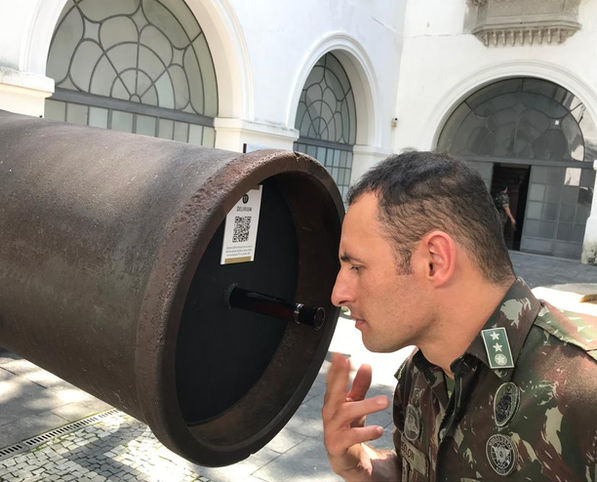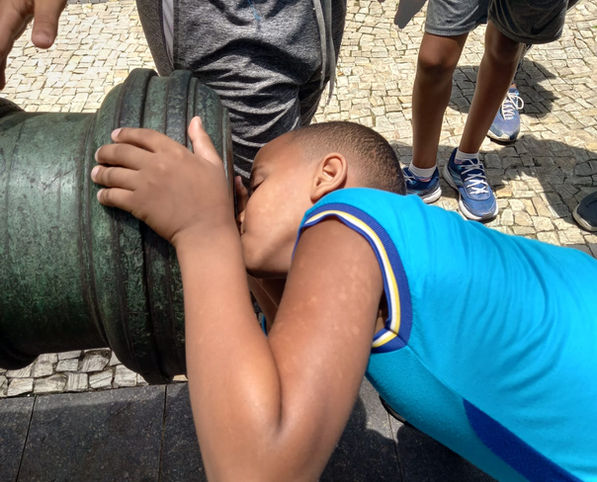JOSELY CARVALHO
multimedia artist

The installation Within the Smells of History is an appropriation of twenty cannons from the Museu Histórico Nacional collection in Rio de Janeiro. Although at first glance it is visual, the outdoor exhibition is meant to be experienced through the viewer’s nose.
November 10, 2022 - January 29, 2023
Smell Walks: November 12, 2022 & January 28, 2023
Museu Histórico Nacional - Praça Marechal Âncora, s/n - Centro - Rio de Janeiro/ BR
Within the smells of history video documentation by Chico Bahia.
Within the smells
of History by
Josely Carvalho
Paulo Knauss
History professor at Federal Fluminense University (UFF)
(former director of the Museu Histórico Nacional)
Cannons are part of the world of weaponsthat tell the history of the wars. The collection of cannons in the Museu Histórico Nacional synthetize the military history of Brazil,since the colonial period till the First World War. It defines a mode to interpret the constructionof Brazilian society.
The installation Within the Smells of Historyis a creation of the contemporary artistJosely Carvalho that presents cannons as objects of history through the sense of smell.
For the artist, “the smells keep the memory of lived experience”, establishing a dialoguebetween past and present.She proposes a different mode to discusshistory through the flavor of air.The exhibit brings the breath as an act of critical thinking facilitated to the public in general.
The artwork of Josey Carvalho is known to bring forth and to discuss the feminine condition.Her interest to the cannons is exactly her intention to question historic interpretations dominated by the male view. The cannons from the different historic periods are monuments of fine sculptural qualities in bronze and iron that celebrate military moments of warriors but hide the memory of violence towards women and children during wars. Exploring the sense of smell, the artist transforms the mouth of a cannon in a time tunnel. The art and act of smell takes us to sensitive histories of Brazil.
To read or listen a history about the cannon and the smell, browse the map below.
The olfactory experience releases memories and affections. Here, connecting patterns of European colonization with its residues that are revealed in Brazilian political and social life.
Can History Have Smells?
Josely Carvalho (2020-2022)
To develop a visual work of art, I began by appropriating 20 cannons from the collection of the National Historical Museum in Rio de Janeiro. Though visual, this artwork is meant to be experienced through the nose. It uses the sense of smell to establish a dialogue between the cannons and the public.
The containers in which the smells nest —memories of history, both violent and affectionate — are not sculpted in blown glass, as were my previous installations. Instead, they are borrowed directly from History, archived today in the courtyard of the museum.
The act of inhaling and exhaling transports us directly to a multiplicity of olfactory experiences, activating memory and emotion. What scents might lead us to comprehend the experiences of those who operated the cannons? What about those who were targeted and hit by the cannonballs — dense spheres of iron, lead, and stone, intended to tear bodies apart in pain? Those bodies did not have the space or solitude or time to record their attachments, their experiences, their longings, their terror.
I think of the cannonball fruit that grows from the flower of the monkey apricot tree. Both fruit and flower hang next to each other from the trunk of the Couroupita guianensis, a tree considered sacred by the Hindus and very present in the Rio de Janeiro landscape. When split open, its fruit — in contrast to the sweet, light, floral fragrance of its flowers — exhales a greasy, antibacterial, sulfuric odor that makes me think of the decomposition of bodies hit by the violence of weapons. Could this tree be a metaphor for the ugly polarization and belligerence manifest in Brazil today?
Standing in the museum’s Pátio dos Canhões, surrounded by its 46 historic cannons, I wonder what secrets have been forgotten beneath the smooth darkness of these obsolete objects, symbols of military, economic, and sexual power?
In my artwork over the decades, the female has been the protagonist while the male has inhabited its edges. To stand amid the cannons in the Pátio dos Canhões reminds us of the patriarchy brought by the colonizers and still present in Brazil. Sexuality is seen and perpetuated as the supremacy of men over women, an attitude that largely explains the recent high rates of harassment, rape, and femicide, not only in Brazil but also in other parts of the world.
Could the nose be considered an instrument with the power to capture emotions and memories? Could different levels of historical understanding be enhanced by olfaction?
In this installation, smell is paired with poetry. Within these deadly nests I locate olfactory traces of life and affection.
I seek to penetrate the deeper meanings of the military history of each of these objects. Their pasts continue to reverberate in our current world, pervaded by violence, territorial monopolies, unequal economic power, fundamentalist doctrines, the dismantling and extermination of cultures, and the many incentives to resort to weapons.
In the burrows of these cannons, I place myself as an interlocutor of time and as a woman.
first Smell Walk Within the Smells
of History - November 12, 2022.
Available only in Portuguese.
Guide: Nina Bruno Malta
Camera & Editor: Diego Avila
Special thanks for the support of the Lee Krasner Award for Life Achievment, Pollock Krasner Foudation.












